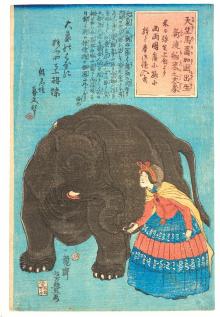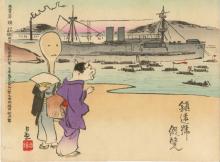Back
Fit to Print: The Dawn of Journalism in Japanese Woodblock Prints from the Lavenberg and Michels Collections
UTAGAWA Yoshitoyo (1830-1866). Japanese; Edo period, 1863. The Grand Elephant: Born and Raised in the Baruka Country of India, Brought Here by Ship (Tenjiku Barukakoku shusshô shinto hakurai no daizō) Birth of the Heavenly Thunder Horse: Newly Imported Great Elephant Born in Masuka, Central India (Tendōba kaminari kakuni shūshō)(detail). Ukiyo-e woodblock print in vertical ōban format; ink and color on paper, 14 1/4 in x 9 1/2 inches. Loan from the Lee & Mary Jean Michels Collection, LMM.0825
KOBAYASHI Kiyochika (1847‑1915). Japanese; Meiji period, 5 February 1878. Memorial Portrait of Kido Takayoshi (1883-1877) with a “Transcript of the Biographical Sketch of Lord Kido Takayoshi from The Day-by-Day News” (Kido Takayoshi-kō ryakuden Nichi Nichi Shinbun yori shō) Portrait of Kido Takayoshi (1883-1877) with a transcript of the biographical sketch of Lord Kido Kōin from the Nichinichi Shinbun. Ukiyo-e woodblock-printed “brocade newspaper” (shinbun nishiki-e) in vertical ōban format; ink and color on paper, H. 14 x W. 9-5/8 inches. Loan from the Lavenberg Collection of Japanese Prints, IHL.1208
KOBAYASHI Kiyochika (1847-1915). Japanese; Meiji period, 1895. Viewing the Zhenyuan (Chin’en-gō goran), from the series Comical Art Exhibit of the Sino-Japanese War Spoiled Chinese Battleship Chinen, from the series Comical Art Exhibit of the SinoJapanese War (Nissei sensō shōôraku gakai). Ukiyo-e woodblock print in horizontal chūban format; ink and color on paper, 7 x 9 1/2 inches. Loan from the Lavenberg Collection of Japanese Print, IHL.0534
Fit to Print: The Dawn of Journalism in Japanese Woodblock Prints from the Lavenberg and Michels Collections
July 31, 2021 to July 31, 2022
In the mid-nineteenth century, Japan’s Tokugawa military regime was in decline. News about political and social events that would previously have been censored began to flood the publication industry during the twilight of the Edo period (1615-1868). With the establishment of the Meiji period (1868-1912), one of the new imperial government’s major modernization efforts was to encourage Western-style journalists to cover, comment, and even critique and satirize, domestic and international events. Japanese writers and artists embraced new media, including newspapers, political cartoons, and comic strips published using intaglio and lithographic technologies that were faster and more economical than labor-intensive traditional woodblock prints. Those involved in the earlier woodblock industry struggled to keep up with the times and began to cultivate new genres such as “brocade newspapers” (shinbun nishiki-e), “civilization pictures” (kaika-e) and propaganda prints depicting the Sino-Japanese (1894-95) and Russo-Japanese (1904-05) warfronts.
This exhibition explores Meiji-period news and reportage in the context of both its Japanese precursors and contemporaneous journalism in other print media. Co-curated by Art History Professor Akiko Walley, East Asian Languages and Literatures Professor Glynne Walley, and Chief Curator Anne Rose Kitagawa, it features more than 30 loans from two remarkably rich local resources, the Lavenberg Collection of Japanese Prints, and the Lee & Mary Jean Michels Collection, along with works from the UO Library’s Special Collections and the museum’s permanent collection.









